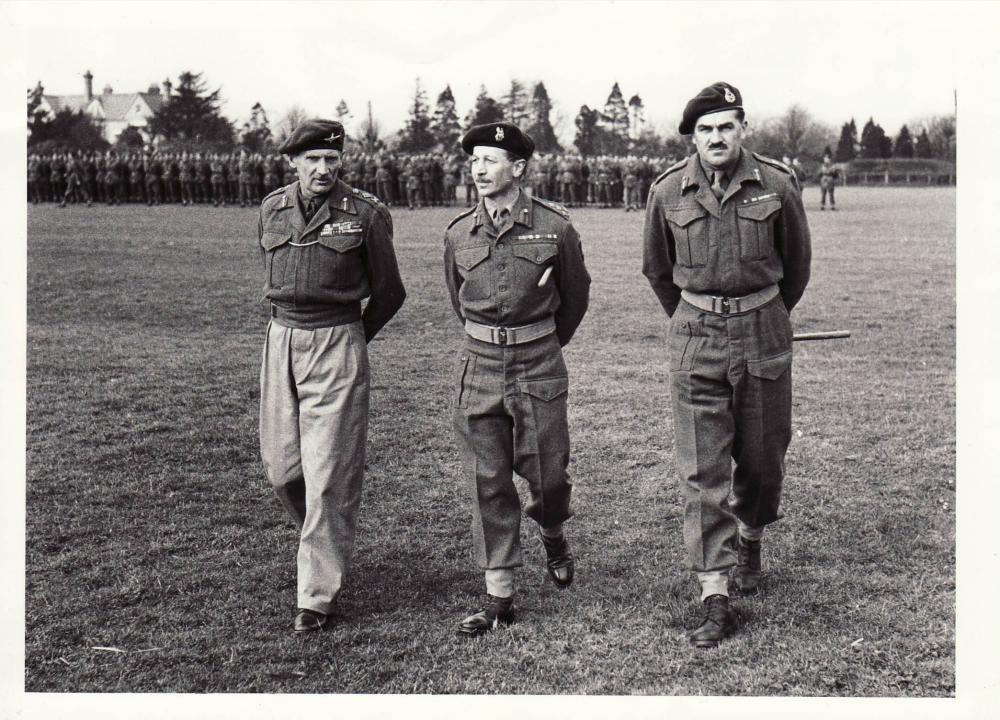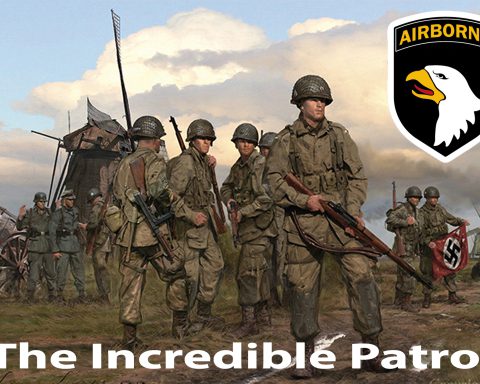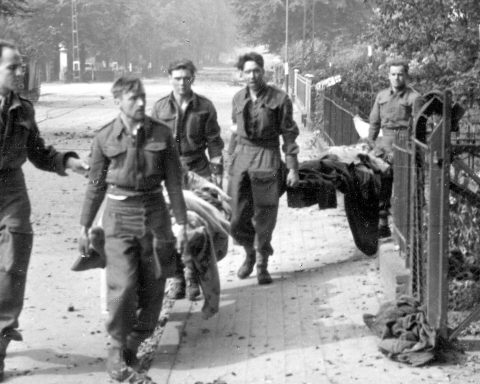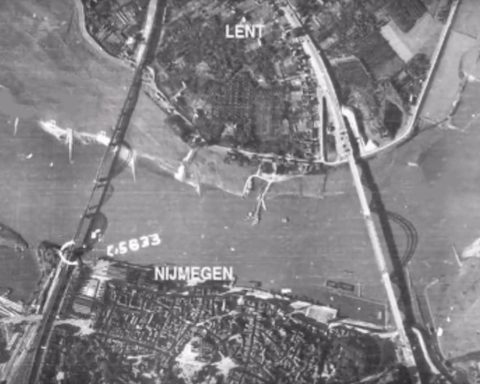The story of General Hackett’s escape is exemplary of the courage of the Dutch resistance to help English soldiers stranded during the Battle of Arnhem.
Brigadier General John ‘Shan’ Hackett was wounded in Oosterbeek on September 24, 1944. Hackett ended up in the Elisabeth Gasthuis. With the help of the resistance, he was able to escape and return to England.
4th Parachute Brigade
General Hackett headed the 4th Parachute Brigade during the Battle of Arnhem. Hackett landed on the Ginkelse Heide together with his brigade on Monday, September 18, 1944. At that time, Operation Market Garden was not going as planned. Yet the prospects at that time were not that bad, as Hackett personally experienced during his landing.
“I didn’t have any weapons with me, but I did have my walking stick,” Hackett said. “My walking stick slipped out of my hands shortly before landing. There were ten German soldiers downstairs who wanted to surrender immediately, but I told them to wait a moment. I had to find my walking stick first. They helped me search.”
However, after this encouraging start, things quickly went wrong. The elements of Hackett’s 4th Parachute Brigade suffered heavy blows during the fighting. Only nine officers and 260 soldiers remained of Hackett’s 4th Parachute Brigade at the end of the Battle of Arnhem. Originally the brigade numbered two thousand soldiers. Many soldiers died, were wounded or were forced to surrender.
General Hackett was also wounded. On September 24, 1944 he was hit by a mortar shell. Hackett, who was wounded in the abdomen, was treated in Hartenstein’s basement.
Elisabeth Gasthuis
That afternoon was at the initiative of the German SS doctor Dr. Egon Skalka agreed a two-hour ceasefire with the British to evacuate the British wounded within the perimeter in Oosterbeek. General Hackett was also evacuated. As a wounded prisoner of war, he was housed in the Elisabeth Gasthuis in Arnhem.
The British doctor Lippman-Kessel, together with SS doctor Skalka, walked past the freshly brought in wounded. According to Skalka, operating on Hackett was pointless: “Kopfschuss, Bauchschuss, Spritze.”
It was best to give soldiers who had a head wound or abdominal wound a morphine injection and stay away from it. In many cases, soldiers with head and abdominal wounds did not survive.
“Well,” Lippman-Kessel replied. “I think I’ll take a chance with this one.”
Although Hackett had been brought in as a ‘corporal’ to prevent the Germans from realizing that they had a general in their hands, Hacket had been immediately recognized by Lippman-Kessel. The two British were good friends.
Hackett had fourteen holes in his intestines, but against all odds Hackett survived the complicated operation.
Escaped
While Hackett was considering ways to escape from the hospital during his recovery after the operation, he was approached by someone who called himself “Piet van Arnhem”. This was the Arnhem resistance fighter Piet Kruijff.
Kruijff asked Hackett if he was able to walk a bit. That worked. A little later, civilian clothes were delivered for Hackett, which he put on. Another resistance fighter with the illustrious name ‘Blue Johnny’ had recently taken those clothes from a house of acquaintances in the area.
Although Arnhem had now been evacuated, there were still quite a few Arnhem residents within the city. German soldiers were camped in the house Johnny passed by, but Johnny rudely announced that it was his house and the Germans agreed that he took a suitcase with some clothes.
After Hackett had put on civilian clothes, he was put in a car by Piet Kruijff. The Arnhem resistance fighters pressed a blood-soaked bandage on Hackett’s head and drove out of the hospital courtyard.
The German soldier who was standing guard a little further away was told that the wounded man in the car had to be taken ‘sofort’ to a hospital in Apeldoorn for surgery. “Seriously injured by air raids,” Piet Kruijff said in German.
The astonished soldier immediately moved aside and the car with Hackett drove away without incident. The escape was successful.
Hiding in Ede
Hackett was brought to Ede by the resistance. There he was first temporarily housed by the retired Dutch soldier Theodoor Boeree. Hackett and Boeree discussed extensively about the course of the Battle of Arnhem. The knowledge that Boeree acquired formed the basis of an extensive report that most historians and writers who have written something about the Battle of Arnhem have used.
After staying at Boeree, Hackett, with the help of the resistance, ended up with the De Nooij family on Torenstraat in Ede. There Hackett meets the British General Lathbury, who has also been smuggled out of the Elisabeth Gasthuis by the resistance in Arnhem.
Hackett received a warm welcome and was very impressed by the friendliness of his new hiding place. In the meantime, the resistance members had arranged for a doctor to look at the wounds. In the months that followed, John Hackett was fully cared for by the De Nooij family and regained his strength.
Visit
Hundreds of British airborne soldiers were in hiding in the Ede area at that time. To the surprise of the De Nooij family, one day the doorbell rings. When they open the door, there is a British soldier in civilian clothes who asks in English if he can speak to Sergeant Hackett. The soldier is Major Digby Tatham Warter who is also in hiding in Ede.
The De Nooij family makes it clear to the British that these types of visits are extremely dangerous and that if the Germans find out that they are hiding British soldiers, they will probably receive the death penalty.
“Cold huh?”
In the weeks that follow, Hackett continues to strengthen. Hackett receives a false identity card through the resistance. Hackett is now Mr. Van Dalen. The resistance also arranges a pin that Van Dalen can wear on his clothing stating that he is deaf and dumb. This way he doesn’t have to talk when he walks outside.
Several plans had already been made by the resistance and the British military leadership to allow John Hackett to escape and were also canceled. Ultimately, the resistance used a well-known escape route via the Biesbosch.
The time had come in early 1945. Hackett cycles from Ede to the Biesbosch together with a resistance fighter. On the way they pass a group of German soldiers and Hackett cannot resist saying “good morning” in his best Dutch, and then adding: “It’s cold, isn’t it?”
To liberated area
At an overnight stop halfway through the journey, Hackett, to his great surprise and joy, also meets Lipmann-Kessel, the British doctor who saved his life in the Arnhem hospital. Lippman-Kessel also went into hiding with the help of the resistance and on his way to liberated areas.
A few days later, Hackett was ferried across the river from Sliedrecht by members of the resistance. The other side of the water is a liberated area. Hackett has brought his British military uniform and puts it on for the crossing.
In the pitch dark, Hackett, together with an underground supervisor, gets into a boat. It has now started to rain, making the view of the water poor. Without paddling, the resistance fighter lets the boat drift with the current, past the German guard posts. When they are at a sufficient distance from the German posts, the two men paddle to the other side.
On the night of February 5, 1945, John Hackett and his companion arrive at Lage Zwaluwe, on the Allied side of the Merwede.
“Hello Shan! We were already expecting you!” it sounds in unadulterated English.
Two days later, Hackett arrives in England and is reunited with his wife.
Hackett: “My wife had just been officially declared a widow two days before. In the British army, anyone missing for more than four months was considered killed.”
Hackett tried to undo his ‘death’ through official channels, but that turned out to be less easy than expected.
Hackett: “You are registered as missing here, the official said. So we can’t do anything. Apparently it didn’t matter that I was standing in front of him in person.”
General Shan Hackett was a welcome guest in the Netherlands after the war until his death in 1997. Until his death, Hackett kept in touch with the Dutch who helped him escape during the war.







